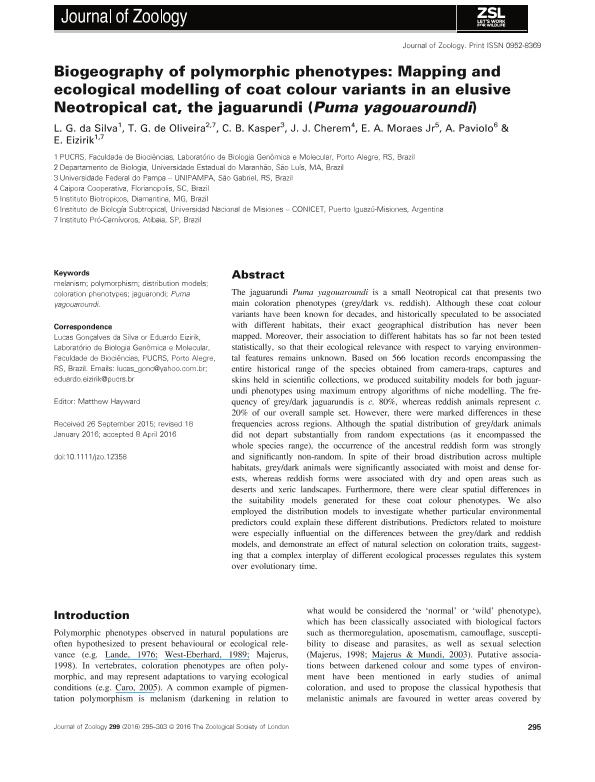Mostrar el registro sencillo del ítem
dc.contributor.author
Gonçalves da Silva, Lucas
dc.contributor.author
Gomes de Oliveira, Tadeu
dc.contributor.author
Kasper, Carlos Benhur
dc.contributor.author
Cherem, Jorge José
dc.contributor.author
Moraes Jr., Edsel Amorim
dc.contributor.author
Paviolo, Agustin Javier

dc.contributor.author
Eizirik, Eduardo
dc.date.available
2018-05-15T20:33:48Z
dc.date.issued
2016-08
dc.identifier.citation
Gonçalves da Silva, Lucas; Gomes de Oliveira, Tadeu; Kasper, Carlos Benhur; Cherem, Jorge José; Moraes Jr., Edsel Amorim ; et al.; Biogeography of polymorphic phenotypes: Mapping and ecological modelling of coat colour variants in an elusive Neotropical cat, the jaguarundi (Puma yagouaroundi); Wiley Blackwell Publishing, Inc; Journal Of Zoology; 299; 4; 8-2016; 295-303
dc.identifier.issn
0952-8369
dc.identifier.uri
http://hdl.handle.net/11336/45277
dc.description.abstract
The jaguarundi (Puma yagouaroundi) is a small Neotropical cat that presentstwo main coloration phenotypes (grey/dark vs. reddish). Although these coat colour variants have been known for decades, and historically speculated to be associated with different habitats, their exact geographic distribution has never been mapped. Moreover, their association to different habitats has so far not been tested statistically, so that their ecological relevance with respect to varying environmental features remains unknown. Based on 566 location records encompassing the entire historical range of the species obtained from camera-traps, captures and skins held in scientific collections, we produced suitability models for both jaguarundi phenotypes using maximum entropy algorithms of niche modelling. The frequency of grey/dark jaguarundis is ca. 80%, while reddish animals represent ca. 20% of our overall sample set. However, there were marked differences in these frequencies across regions. Although the spatial distribution of grey/dark animals did not depart substantially from random expectations (as it encompassed the whole species range), the occurrence of the ancestral reddish form was strongly and significantly non-random. In spite of their broad distribution across multiple habitats, grey/dark animals were significantly associated with moist and dense forests, while reddish forms were associated with dry and open areas such as deserts and xeric landscapes. Furthermore, there were clear spatial differences in the suitability models generated for these coat colour phenotypes. We also employed the distributionmodels to investigate whether particular environmental predictors could explain these different distributions. Predictors related to moisture were especially influential on the differences between the grey/dark and reddish models, and demonstrate an effect of natural selection on coloration traits, suggesting that a complex interplay of different ecological processes regulates this system over evolutionary time.
dc.format
application/pdf
dc.language.iso
eng
dc.publisher
Wiley Blackwell Publishing, Inc

dc.rights
info:eu-repo/semantics/openAccess
dc.rights.uri
https://creativecommons.org/licenses/by-nc-sa/2.5/ar/
dc.subject
Melanism
dc.subject
Polymorphism
dc.subject
Distribution Models
dc.subject
Jaguarondi
dc.subject
Coloration Phenotypes
dc.subject
Puma Yagouaroundi
dc.subject.classification
Otras Ciencias Biológicas

dc.subject.classification
Ciencias Biológicas

dc.subject.classification
CIENCIAS NATURALES Y EXACTAS

dc.title
Biogeography of polymorphic phenotypes: Mapping and ecological modelling of coat colour variants in an elusive Neotropical cat, the jaguarundi (Puma yagouaroundi)
dc.type
info:eu-repo/semantics/article
dc.type
info:ar-repo/semantics/artículo
dc.type
info:eu-repo/semantics/publishedVersion
dc.date.updated
2018-05-04T20:15:45Z
dc.identifier.eissn
1469-7998
dc.journal.volume
299
dc.journal.number
4
dc.journal.pagination
295-303
dc.journal.pais
Reino Unido

dc.journal.ciudad
Londres
dc.description.fil
Fil: Gonçalves da Silva, Lucas. Pontificia Universidade Católica do Rio Grande do Sul; Brasil
dc.description.fil
Fil: Gomes de Oliveira, Tadeu. Universidad Estadual Do Maranhao; Brasil
dc.description.fil
Fil: Kasper, Carlos Benhur. Universidade Federal do Pampa; Brasil
dc.description.fil
Fil: Cherem, Jorge José. Caipora Cooperativa; Brasil
dc.description.fil
Fil: Moraes Jr., Edsel Amorim. Instituto Biotrópicos de Pesquisa em Vida Silvestre; Brasil
dc.description.fil
Fil: Paviolo, Agustin Javier. Consejo Nacional de Investigaciones Científicas y Técnicas. Centro Científico Tecnológico Conicet - Nordeste. Instituto de Biología Subtropical. Instituto de Biología Subtropical - Nodo Puerto Iguazú | Universidad Nacional de Misiones. Instituto de Biología Subtropical. Instituto de Biología Subtropical - Nodo Puerto Iguazú; Argentina
dc.description.fil
Fil: Eizirik, Eduardo. Pontificia Universidade Católica do Rio Grande do Sul; Brasil
dc.journal.title
Journal Of Zoology

dc.relation.alternativeid
info:eu-repo/semantics/altIdentifier/url/https://zslpublications.onlinelibrary.wiley.com/doi/abs/10.1111/jzo.12358
dc.relation.alternativeid
info:eu-repo/semantics/altIdentifier/doi/http://dx.doi.org/10.1111/jzo.12358
Archivos asociados
